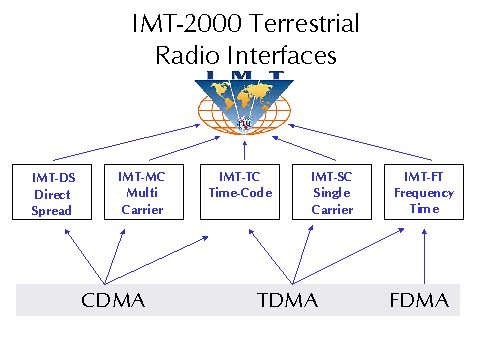Definition of International Mobile Telecommunications-2000 (IMT-2000) in Network Encyclopedia.
What is IMT-2000 (International Mobile Telecommunications-2000)?
IMT-2000 stands for International Mobile Telecommunications-2000, is an initiative of the International Telecommunication Union (ITU) to create a global standard for wireless data networks.

When it was created, the goal of International Mobile Telecommunications-2000 (IMT-2000) was to support data transmission rates of up to 2 Mbps for fixed stations and 384 Kbps for mobile stations. Note that the “2000” in the term “International Mobile Telecommunications-2000” refers to the transmission speed (approximately 2000 Kbps), not the deployment date (which might be several years beyond the year 2000).
IMT-2000 consists of several sets of standards, including the following:
- CDMA2000: A proposed hardware upgrade to the existing Code Division Multiple Access (CDMA) cellular phone systems used in the United States and in some parts of Asia
- W-CDMA: A proposed upgrade to Global System for Mobile Communications (GSM) networks that provide an alternative air interface to CDMA2000 for upgraded CDMA systems in Europe and Japan
- Universal Mobile Telecommunications System (UMTS): A standard for 3G (third-generation) wireless networks proposed by the European Telecommunications Standards Institute (ETSI)
- Universal Wireless Communications (UWC-136): A standard for 3G wireless networks proposed by the Telecommunications Industry Association (TIA)
Because of the fundamental inoperability between the two major types of cellular communication technologies – Time Division Multiple Access (TDMA) and CDMA – the ITU hopes that this initiative will unify wireless mobile communication worldwide by upgrading both TDMA and CDMA systems to a single global standard. However, the IMT-2000 initiative will not immediately result in a single worldwide air interface for wireless communication.
The upgrade for CDMA bearers will be simpler and will move them directly from the current IS-95a standard called CDMAone (the brand name used by the vendor consortium called the CDMA Development Group for existing data transmission at 16 Kbps) to the proposed CDMA2000. The upgrade for TDMA bearers can take several different paths – for example, from TDMA to General Packet Radio Service (GPRS) to Enhanced Data Rates for Global Evolution (EDGE) to UMTS. Some industry watchers predict that GPRS and IMT-2000 will be widely adopted worldwide in the next five years, which will give Europe and Asia an edge in high-speed wireless data communication over the United States, where as many as five competing systems might be deployed widely.
Frequency bands
The frequency bands 1885-2025 MHz and 2110-2200 MHz were identified for IMT-2000 by the ITU in 1992. Terrestrial IMT-2000 networks will operate in the following bands:
- 1920 – 1980 MHz paired with 2110 – 2170 MHz,
FDD with mobile stations transmitting in the lower sub-band. - 1885 – 1920 MHz and 2010 – 2025 MHz,
unpaired for TDD operation.
In Europe is the TDD band from 1885-1900 MHz not available for licenses use of IMT-2000, this is used by cordless telephony (DECT).
In addition to this core-band the frequency band 2500 to 2690 MHz was identified in 2000, of which the edges, ranging from 2500-2520 and 2670-2690 MHz, are at first identified for satellite communications. Existing second generation bands (including GSM bands) 806 to 960 MHz, 1429 to 1501 MHz and 1710 to 1885 MHz are also identified for IMT-2000 in the long term.
NOTE
3G wireless communication systems are those that provide transmission quality similar to Integrated Services Digital Network (ISDN) phone systems. First-generation systems are the analog cellular phone systems such as the Advanced Mobile Phone Service (AMPS) in North America, and second-generation systems are widely used digital cellular phone systems such as the Digital Advanced Mobile Phone Service (D-AMPS), CDMA systems, TDMA systems, and GSM.